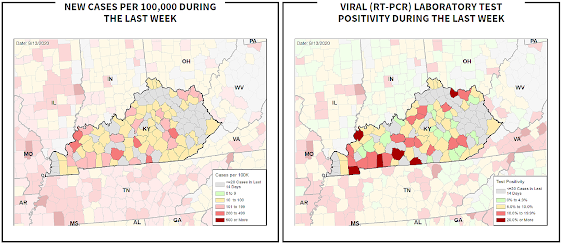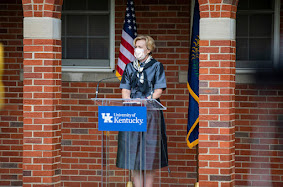 |
| White House Coronavirus Task Force tables; click on image for a larger version. |
Kentucky Health News
Kentucky showed some slight improvement on the latest White House Coronavirus Task Force report, for the week of Saturday, Sept. 5 through Friday, Sept. 11. Seven fewer counties were in danger zones and only one metropolitan area, Bowling Green, was in the red zone.
Fifty-seven of the state's 120 counties were in the high-risk zones for the reporting week, down from 64 the previous week. Thirteen counties were in the red zone, down from 24 counties and eight metro areas. Most moved into the yellow zone, which had 44 counties, four more than the previous week.
Communities in the red zone have weekly positive-test rates higher than 10 percent and more than one new case per thousand residents. Yellow-zone communities have new cases between 0.1 and 1 case per 1,000 and a positive-test rate of 5% to 10% -- or one of those, with the other in the red zone.
 |
| White House Coronavirus Task Force maps; for a larger image, click on it. |
Nearly all the state's hospitals, 95%, reported a newly confirmed or suspected case of covid-19 each day. On average, 307 confirmed and 384 suspected covid-19 patients were newly admitted each day to Kentucky hospitals. The capacity of hospitals is a key metric in determining whether the state's economy can remain open.
 |
| Dr. Deborah Birx visited the University of Kentucky on Monday. (Photo by Pete Comparani, UK) |
“We continue to see a week-over-week improvement in Kentucky due to the strong work Kentuckians have done to follow guidelines such as social distancing and wearing masks,” Birx said during a media briefing.
Her praise comes as the Kentucky Supreme Court is set to hear its first day of oral arguments against Gov. Andy Beshear's covid-19 emergency public health orders, including the mask mandate, today. The proceedings will take place Sept. 16-18 and can be watched via the Supreme Court's livestream or via a Kentucky Educational Television livestream.
Unlike previous reports, this week's report does not include language that says bars must be closed and indoor dining must be restricted to 50% of normal capacity in yellow zones and 25% of normal capacity in red counties and metro areas. It says, "In areas with ongoing high levels of transmission (red and yellow zones), use standard metrics to determine school learning options and capacity limits for bars and indoor dining." It does not provide those standard metrics. Click here for the federal "considerations for restaurants and bars."
On Tuesday, Gov. Andy Beshear announced that bars and restaurants will be allowed to stay open an extra hour, moving last call to 11 p.m. The establishments must continue to operate at 50% capacity, patrons must remain seated unless going to the bathroom and they must close by midnight.
At his Sept. 15 daily briefing, Beshear said he made the change at the request of restaurants. He said Kentucky, like some other states, has gone against White House recommendations and allowed bars and restaurants to remain open at a larger capacity as a way to create a more controlled social setting that discourages house parties and to provide an avenue for small businesses to stay open.
The White House report calls for Kentucky to develop a plan for increased surveillance of asymptomatic carriers and to establish weekly testing among critical populations, like teachers and nursing home staff, to monitor the degree of community spread. It also recommends wastewater surveillance at universities to allow for targeted testing. UK has started such testing.
The report also points to the need to review and improve infection control practices at nursing homes to stop the introduction of covid-19. This week's report shows that during the week of Aug. 31-Sept. 6, 10% of Kentucky's nursing homes had at least one new resident case, 20% had at least one new staff case; and 6% had at least one new resident death.
No comments:
Post a Comment